Yavuz Sultan Selim Mosque Istanbul- Is it underrated?
Yavuz Sultan Selim Mosque- Information
Here it is, another great one, Yavuz Sultan Selim Mosque in Istanbul… We are continuing to explain the great mosques in Istanbul after the Blue Mosque and the Suleymaniye Mosque.
So, we think that Yavuz Sultan Selim Mosque (often called as Sultan Selim Mosque or Yavuz Selim Mosque) is one of the best mosques in Istanbul. The complex (külliye in Turkish) and overlooking Golden Horn is amazing.
The mosque is constructed on the fifth hill. We can say that this is a mid-size mosque. Before going further, the complex itself does not only contain the mosque. Especially, old people or emperors preferred to construct a complex including a mosque, an almshouse, a primary school (Sibyan mektebi in Turkish), bath and more on. So, this one also represents this style.
The complex was restored a couple of times in 1930, 1962 and between 2006-2010. We are lucky that there is no on-going restoration.
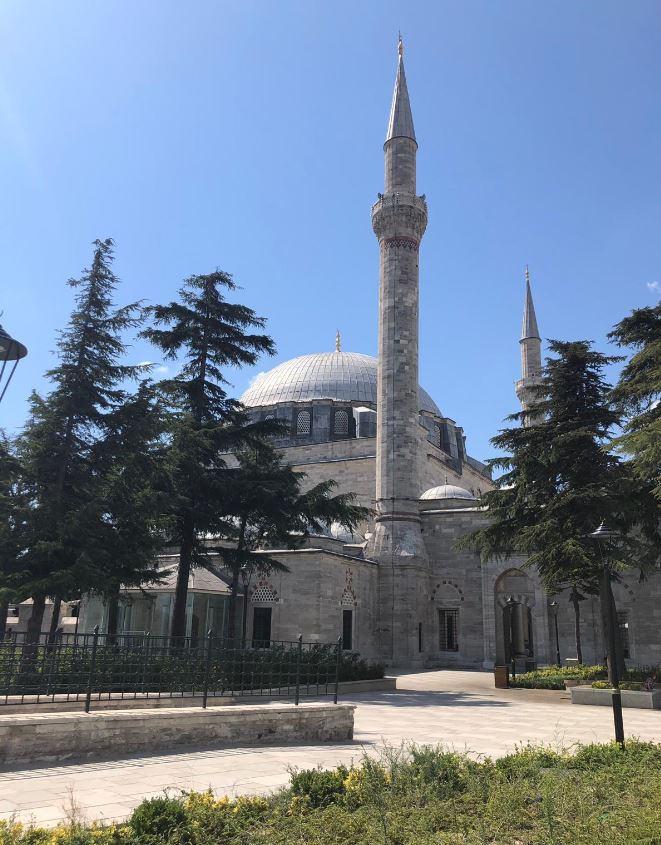
Yavuz Sultan Selim Mosque- History
Sultan Selim I
Before checking the mosque deeper, we should talk about Yavuz Sultan Selim. So, Selim I is the 9th Sultan of the Ottoman Empire. And, his son is Suleyman (or Suleiman) the Magnificent. Sultan Selim is also known as “The Grim” due to his power and bravery. But, we like his intelligence level rather than his power.
He solved a lot of problems in the East of the Ottomans and expanded the territory. Unfortunately, he couldn’t govern the empire for a long time, it was just around 8 years. There is a story about his success in the East territorial borders. He said, “I cleaned the chaos in the East, so here is my son Suleyman’s turn to expand the territories in the West”. So, Suleyman the Magnificient did it and made a lot of moves in the West.
He died in 1520 and Suleyman the Magnificient became the new emperor.
The Complex
There are some discussions on-going about this mosque 🙂 According to panels in the mosque which are both Turkish and English and several resources, it is understood that the complex was constructed by his son. So, Suleyman ordered for the mosque and the construction was taken place between 1522-1529. But based on the inscription written in Arabic on the door, the construction was made in the name of Sultan Selim. However, additional info on the Sultan Selim’s tomb describes that the tomb was constructed by the Sultan Suleyman.
So, here are our outputs. It was a common practice in the Ottomans to construct a splendid mosque after huge victories. Yavuz Sultan Selim probably wanted to make a great mosque due to his victories in the East. For this reason, it is highly probable that he wanted a mosque on the top of this hill. Or, Sultan Suleyman- his son might have known his father’s intention and he didn’t let them write his name to the main gate due to his respect to his father. But who knows, at least it is obvious that the complex construction was completed in the Suleyman’s period. [1]
Mimar Acem (Persian) Ali was the architect of this mosque. There are also some discussions on-going about the architect. Due to reflecting the legend Mimar Sinan’s style little bit, some resources mention that the architect Sinan was the owner of this plan. But, at that time, he was not a well-known architect, so thinking the architect Persian Ali is the right person makes much more sense. [1]
Yavuz Sultan Selim Mosque- What does the Complex Contain?
The mosque is part of the complex. So, the complex currently contains the mosque, a primary school which is actively used, and tombs. Unfortunately, the almshouse and the baths do not exist. It is believed that the high school currently standing at one of the gates was the almshouse but an earthquake collapsed the old building.
Before starting, the mosque and complex are too bulky, isn’t it? But, you know the mosque is on the hill, one side is looking to Cukurambar (Aspar Cistern) currently is a park and the other side is at the edge of a cliff. They probably wanted a bulk structure due to not having enough strength coming from the ground. So, you will see multiple columns in the courtyard. Side rooms in the courtyard are directly connected to the mosque which is a unique property for Yavuz Sultan Selim Mosque.

You can enter the complex from one of the gates which are named as the bazaar, tombs, and 40-stairs.
The dome diameter is 24.5 meters. You can see that the big domes are not supported by smaller domes. Some portion of the dome has livid colors which shows a good view.
The mosque itself contains two minarets having only one serefes (balconies). It has a square plan. The inner courtyard has a fountain for the ablution. This is 8th columned and looks good.
Sultan Selim Mosque- Interior Design
The mosque is a mid-sized, so the capacity is not very big. You know Suleymaniye’s capacity is 27,000 [2]. Camlica Mosque in Istanbul has just been opened and it can serve up to 63,000 people.
The mosque’s interior is so modest. And, you will be seeing some calligraphies on the walls containing quotes from Qur’an, and a few tiles. Moreover, the combination of stained glass colors and dome is good.
The chandelier is very close to the ground like other mosques. This is a simple design and not very modern. But, the lighting is good. Moreover, the sunlight is always in the mosque due to having a lot of openings to the out. You will be seeing a marble Minbar (Imams use for sermons) and a marble Mihrab (indicating the direction of Mecca) on the forward side. Additionally, this one has also 8th columned Sultan lodge. This was mostly used by Sultan and his family.
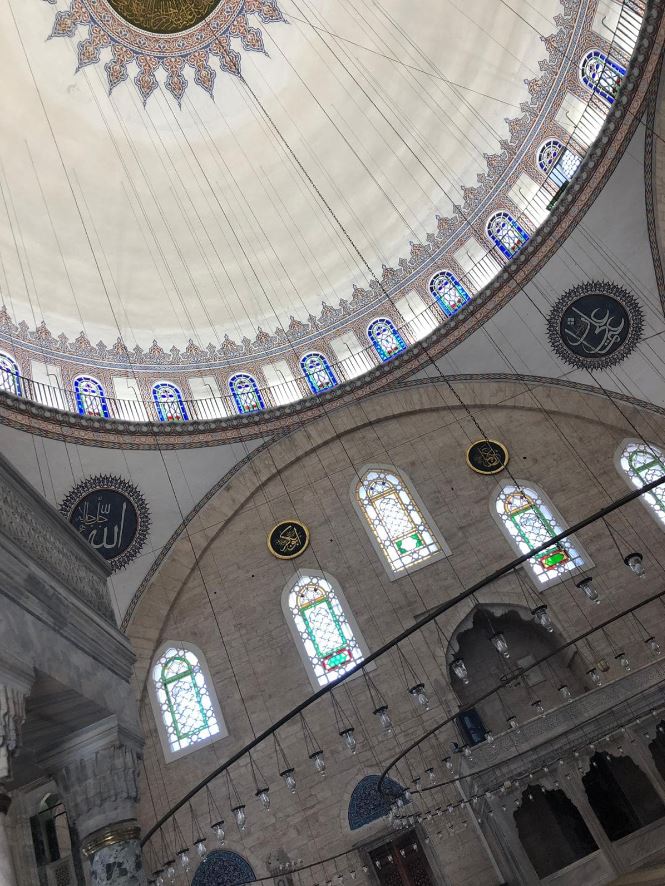
Yavuz Sultan Selim Mosque- Who is Buried?
The important figures’ tombs are in the complex.
Sultan Abdulmecid
When you enter this area, you will first see the Sultan Abdulmecid’s tomb. Sultan Abdulmecid is also an important figure in the Ottomans late period. He is the 31st Sultan of the empire. In his period, the Westernization process reached the top level and he tried to fasten this process.
The tomb is octagonal and has a dome. Like it was explained in the area, Garabet Balyan, who was also the architect of Dolmabahce Palace, is the possible candidate of this tomb’s architect. It is currently an unknown 🙂 The tombs of Sultan Abdulmecid’s sons Abdussamed, Seyfeddin and Burhaneddin are also here.
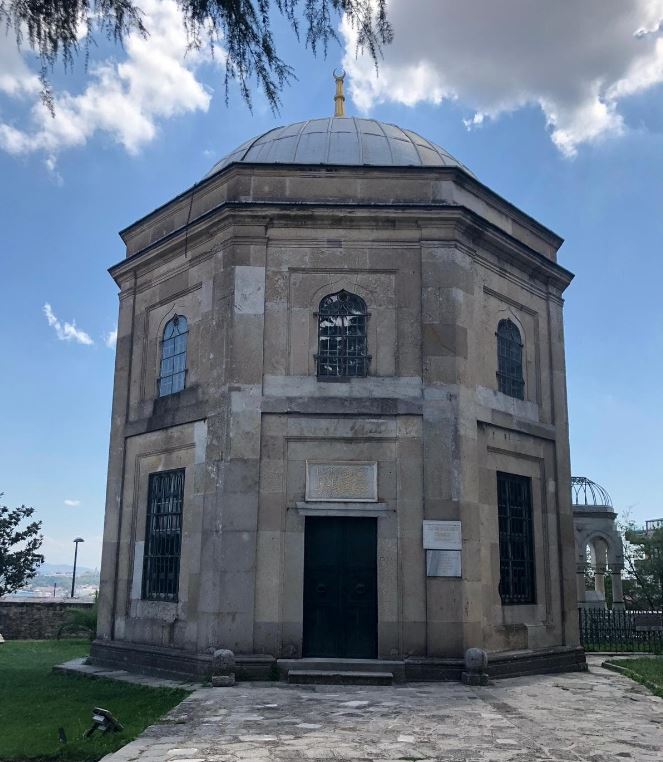
Ayse Hafsa Sultan
And then, you will see the tomb of Sultan Suleyman’s mother- Ayse Hafsa Sultan. She is well known for her generosity. It is a weird story, but this tomb demolished by an earthquake at the end of the 1800s and waited for the re-construction around 100 years. During excavation for the foundation, surprisingly another grave has been found. And, that grave belongs to Sah Sultan who is the daughter of Yavuz Sultan Selim and Ayse Hafsa Sultan.
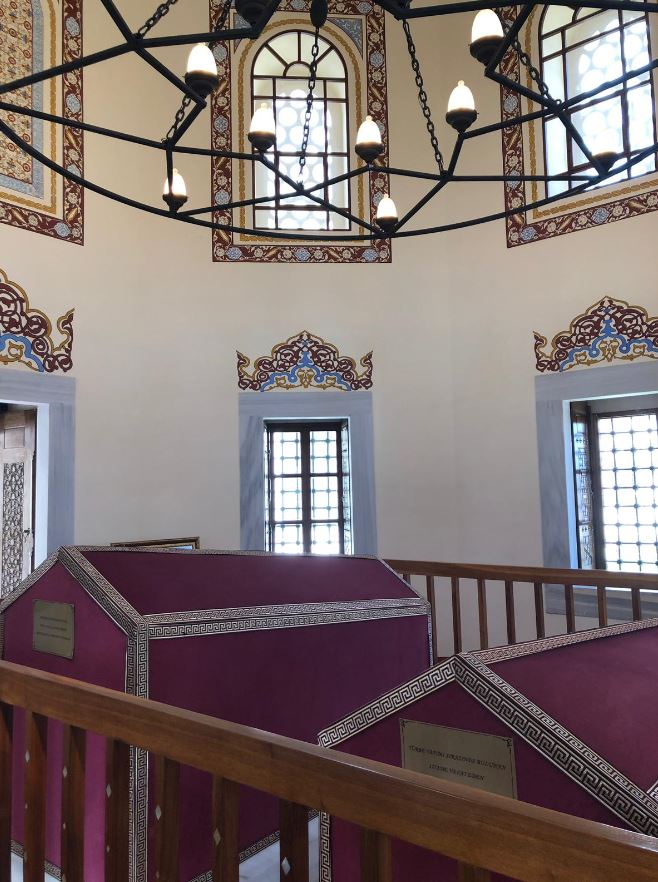
Yavuz Sultan Selim
As expected, Yavuz Sultan Selim’s tomb is the most interesting among all because of the two stories we will be explaining. The structure is octagonal and there are some windows around it. Moreover, you will notice the tiles as well.
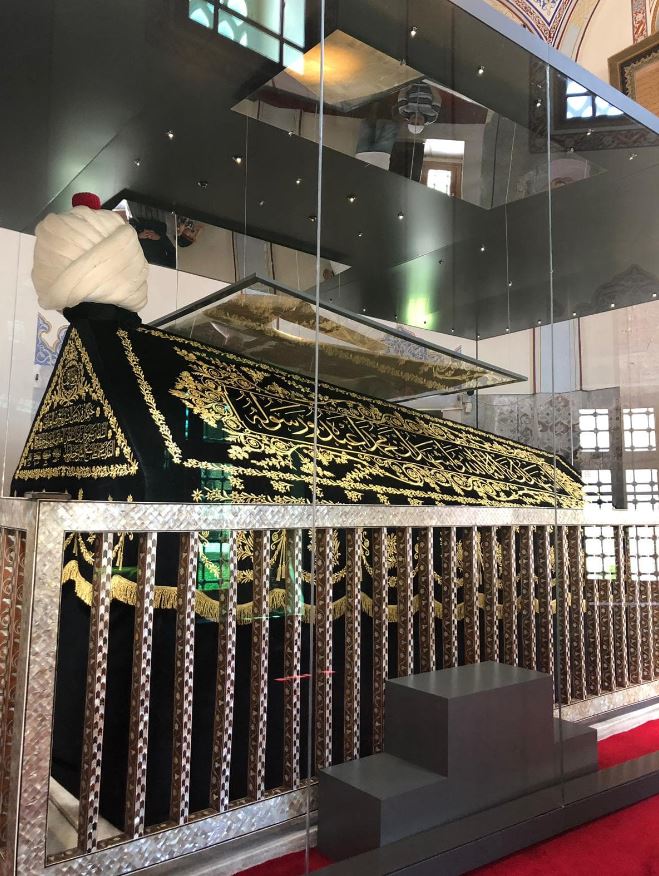
The Kaftan
The kaftan or caftan on the coffin has mud on it. You can check this one with the mirror placed on the kaftan. So, here is the first story. It is well known that Yavuz Sultan Selim didn’t like to waste any time and was spending his time with well educated and religious people. While returning from a campaign and during a conversation with Shaykh al-Islam Ibn-i Kemal, mud splashed from Ibn-i Kemal’s horse and polluted the Sultan’s kaftan. But, Yavuz Sultan Selim responded surprisingly. “I accept everything coming from these people and my will is to present this kaftan in my tomb.” So that this kaftan is currently being shown on the coffin.
Sin Sin Stone
The other story is about Sin Sin (Sin Şın in Turkish) stone in the tomb.
During the Egypt campaign, Yavuz Sultan Selim stayed in Damascus (Sam in Turkish, the capital of Syria). While reading a book of an important person Muhyiddin-i Arabi before, he observed a quote “When Sin enters Sin, the Mim’s grave appears”. And then, the Sultan evaluated this quote with Shaykh al-Islam Ibn-i Kemal and they came to a conclusion that Sin is himself- Sultan Selim, the other Sin (Şın) is Damascus and Mim is Muhyiddin-i Arabi.
Somehow, this person’s grave couldn’t be found at that time because of some sarcastic words against rich people. And then, Muhyiddin-i Arabi appeared in Sultan’s dream and he said. “Selim, I was waiting for you. Welcome. You will be successful in Egypt. Tomorrow, get on a black horse after waking up. It will find me, please construct a tomb and mosque for me.” Sultan Selim woke up and got on a black horse. It rode him to a garbage dump. The horse started scratching. Sultan ordered the people around to scratch and they found the grave.
Sultan went to Egypt and after this successful campaign, he came back to Damarcus and stayed over four months. He ordered a mosque and a tomb. And this stone was written with “When Sin enters Sin (Şın in Turkish), the Mim’s grave appears.” and was placed to the Sultan’s tomb.
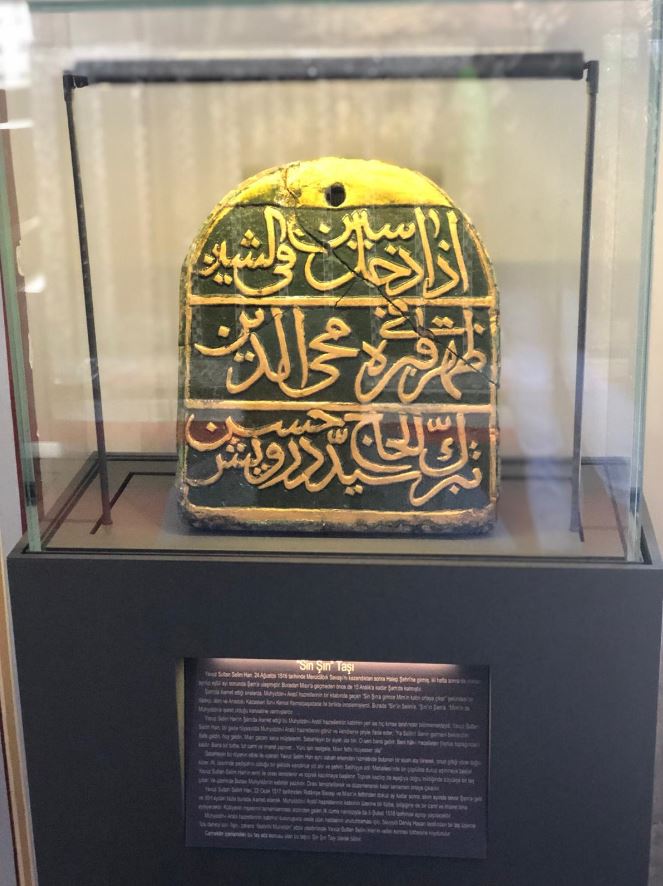
Yavuz Sultan Selim Mosque- Prayer times
This is six times per day. Basically, each of them is calling the prayers at different times during the day starting from midnight (Fajr in Arabic), morning (Tulu in Arabic), noon (Zuhr in Arabic), afternoon (Asr in Arabic), evening (Maghrib in Arabic) and night (Isha in Arabic).
Do not forget that it is not possible to check the interior during prayer time. So, you should be careful about timing. Regardless of prayer time, anyone can come and pray in the mosque. So, it would be good to be silent and respectful inside of any mosque.
Sultan Selim Mosque- Visiting hours
You know, the mosques are always open unless there is a restoration. However, since it is an active one, it is better to be careful about timing. So, check this reference to see the call for prayers [3]. Moreover, we recommend you to check the complex between morning-noon or noon-afternoon.
Friday noon is also different than standard times. There is a special sermon and people are together for praying. So, if you are planning to go on Friday, we recommend you to go there after 2 p.m. The tombs are closed on Mondays which may not be a good day to check this complex.
A tough winter can be a little bit challenging for this mosque since it is on a hill. And, you can check the generic seasonal info regarding Istanbul in this post.
Sultan Selim Mosque – Dress Code
The figure below represents how you should cover yourself. In summary, men should cover till knee cap and women should cover their head, shoulder and till their feet. Please make sure you are good to go based on the figure below.
Additionally, do not forget to take something with you in order to cover your head. As you observed, this figure is from the Blue Mosque. It would be hard to find a scarf in the mosque since this is not very touristic mosque 🙂

Yavuz Sultan Selim Mosque- Entrance Fee
For your information, if it is allowed to pray in a mosque, nobody can charge you. It is totally free. So, the museum pass question does not make any sense.
The mosque itself is super clean, so it deserves a donation like Suleymaniye Mosque.
Suleymaniye Mosque vs Yavuz Sultan Selim Mosque
We really like the Suleymaniye Mosque. The complex, especially in the Ramadan period, is amazing. However, this selection is a little bit tough and a lot of people would prefer to be seeing the Suleymaniye Mosque. One of the reason is definitely to be the sign of the architect Sinan. He is a legend, so feeling his architecture is fantastic.
Suleymaniye Mosque is bigger and interior design quality is a little bit better. And, the acoustics in Suleymaniye is also very good since the architect Sinan showed extra care. The whole complex sizes are not so different. Moreover, both complexes have important figures’ tomb. You will enjoy the views while overlooking the Golden Horn.
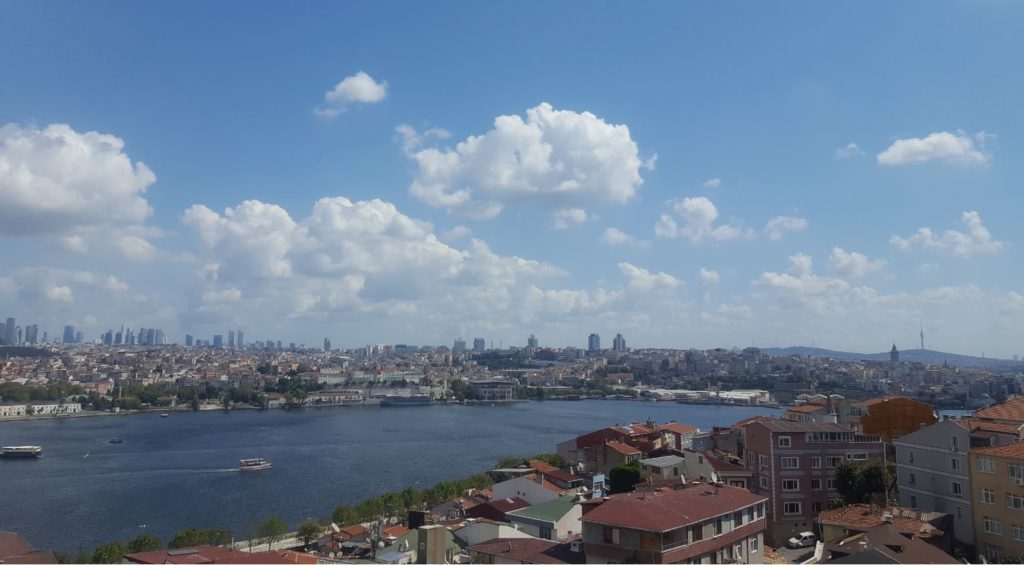
But, per our perspective, the most positive thing about the Yavuz Sultan Selim Mosque, there are not many tourists, and sometimes, especially in peak tourist times in Istanbul, Blue Mosque and Suleymaniye Mosque are full of people. Since this mosque is underrated, you can enjoy every square meter very comfortably. It is a local one but please remember our motto: “Listen Istanbul from locals and explore secret places”. We can’t say it is a secret place since it is on the top of the hill 🙂 But it is a local one and very good spot to see a different local side of Istanbul. But, please note that this is the conservative side of Istanbul. And the atmosphere here is pretty good.
In summary, if you are planning to visit Fener and Balat, do not miss the Yavuz Sultan Selim Mosque, but your choice here should be shaped with your plan in Istanbul. For instance, it is not right to say covering Blue, Suleymaniye, Fatih and Yavuz mosques is a must in only three days 🙂
Where is the Yavuz Sultan Selim Complex?
The mosque is in Fatih district. And, the official address is Balat, Sultan Selim Cd. No:18, 34087 Fatih/Istanbul
What to do around the Complex?
We hope you will be spending some time around the Cibali, Fener and Balat regions. We recommend you to check the small streets, enjoy the cafes and visit Fethiye and Chora museums, the Greek Patriarchate and the Bulgarian iron church. This is not limited, but it depends on your available time in Istanbul.
Theoretically, there are two cisterns around the complex. One of them is Aspar Cistern and the other one is Sultan Cistern. Aspar Cistern which is called as Cukurbostan in Turkish was a huge open cistern. But, this is currently a park. However, you can check out the walls and they belong to Aspar Cistern. The other one, Sultan Cistern is pretty amazing but it is currently an activity center for weddings and ceremonies. However, you can still go and check inside of this cistern if they allow and it is very close. Before noon can be good for the Sultan cistern.
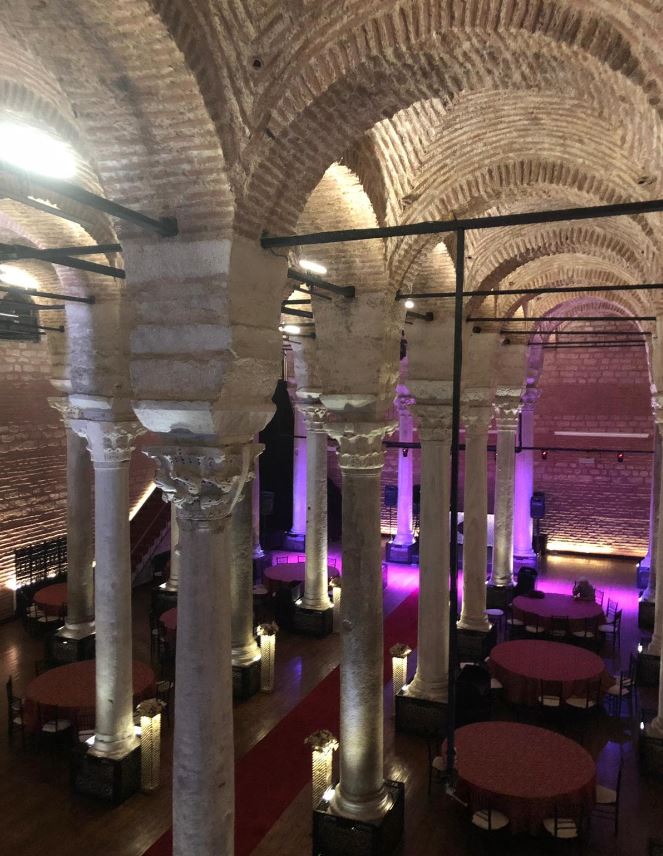
How to Reach Yavuz Sultan Selim Mosque- Transportation Guide
Since the mosque is not far away from the Blue Mosque, Hagia Sophia, Eminonu and Karakoy- Galata Tower, you would prefer to catch a taxi and it will not cost a lot.
From Eminonu
Some lines use the coast road. So, you can get off at Ayakapi stop and walk to the hill. But it is very steep, so walking is too tough. If you want, you can use 36CE, 44B, 48E, 99A or 99Y.
Otherwise, the other route is to get off at Yavuz Selim after going there by 36A, 36V, 37Y, 38B, but again there will be a distance that you should walk.
But, 28, 28T and 90 is really getting closer and the stops are very close. Don’t forget to get off when you are around Carsamba Cukurbostan Park.
From Kadikoy
You can go to Eminonu via ferries and follow the section above.
From Uskudar
You can directly use the city lines ferries- Uskudar- Eyupsultan and go to Fener stop. And then you should walk to the hill 🙂
Conclusion
As a reminder, this region really represents Istanbul’ s conservative face. You will feel it when you are in this region.
Sultan Selim complex is pretty good. And yes, it is underrated. To be honest, we really like the Blue Mosque and the Suleymaniye Mosque due to their spiritual atmosphere.
If you want to visit a mosque away from the crowdedness and feel as pleased as Suleymaniye Mosque, you can choose to visit Yavuz Sultan Selim complex. But you know our favorite mosque in Ramadan is Suleymaniye Mosque. So, consider the timing as well 🙂 We understand that it is just a personal preference. Additionally, the view is perfect, you can really enjoy it.
In summary, it is totally worth visiting, but also consider your timing. To put pure three or more mosques in schedule can be challenging for a short period. But when we say “pure”, this doesn’t include the mosques converted from church like Hagia Sophia.
Moreover, there are many good places in Fener and Balat regions. Don’t forget to visit the Greek Orthodox Patriarchate, Fethiye Museum, Chora Museum, the Bulgarian iron church, etc. and spend some time in these district’s streets.